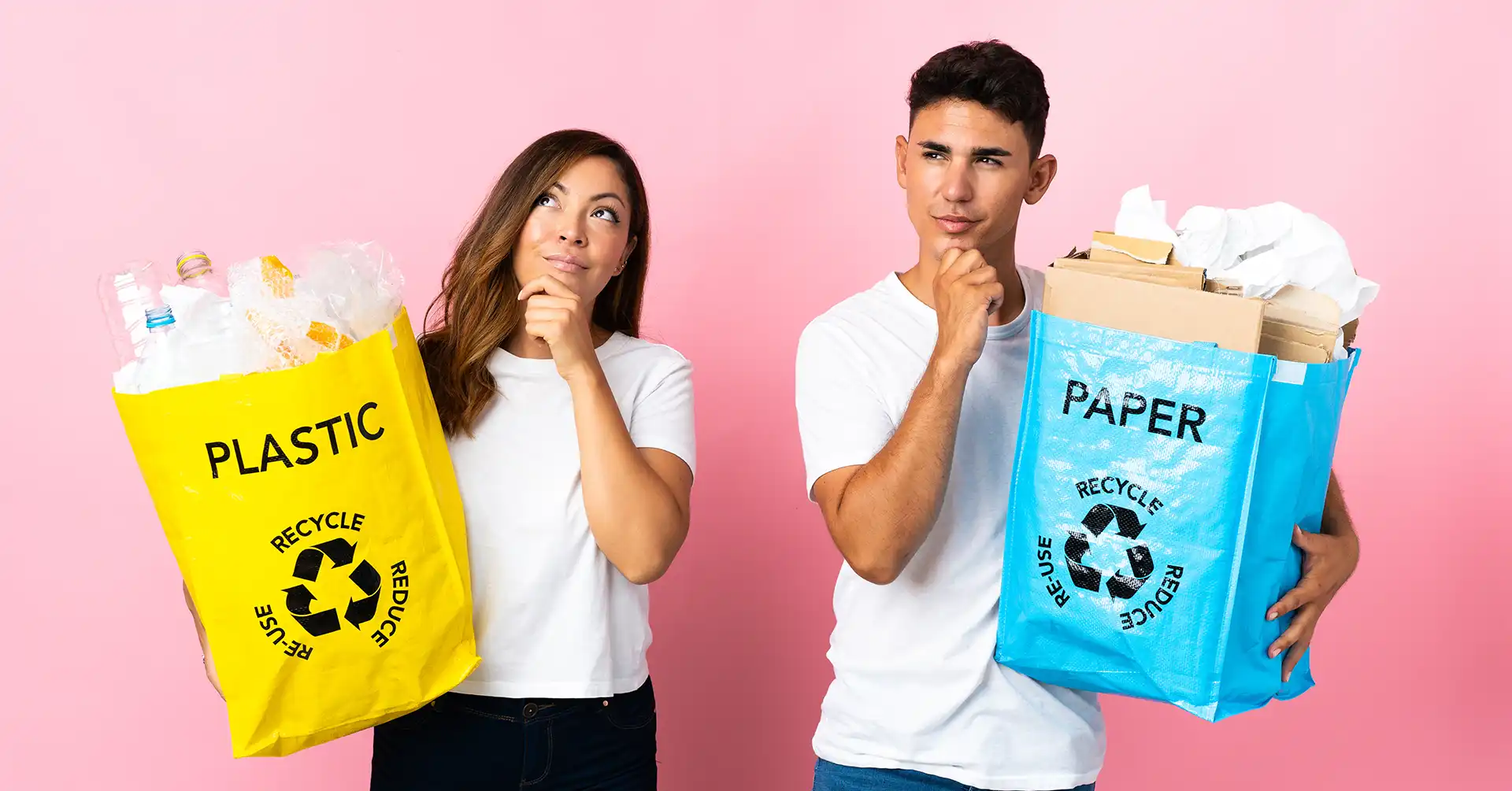Proper waste disposal is crucial for maintaining cleanliness and sustainability in communities across the United States. Effective trash vs. recycling management not only enhances environmental health but also conserves resources and reduces landfill waste. By understanding the distinctions between what should be trashed and what can be recycled, individuals contribute to a cleaner environment and support local recycling efforts.
Meet Sarah, the Eco-conscious Mom
Sarah is a passionate advocate for sustainable living in her suburban neighborhood of Denver, Colorado. With a keen interest in waste reduction, she actively educates her community on the importance of trash vs recycling. Through her blog, “Green Living Tips,” Sarah shares practical advice on how families can minimize waste and maximize recycling efforts at home.
Introducing Mike, the Recycling Enthusiast
Mike, based in Portland, Oregon, is known for his dedication to recycling initiatives in his city. As a volunteer at local recycling events, Mike educates residents on the proper sorting of materials and advocates for responsible waste disposal practices. His goal is to inspire others to make a positive impact by understanding the difference between trash vs recycling.
Emily: Environmental Advocate and Educator
Emily, from Austin, Texas, is a committed environmental educator who believes in the power of community action. Through workshops and outreach programs, she teaches students and adults alike about the benefits of recycling and proper waste management. Emily encourages everyone to embrace sustainable habits by making informed choices about their trash vs recycling practices.
Meet David, the Sustainability Consultant
David, a sustainability consultant based in Seattle, Washington, helps businesses and organizations implement eco-friendly practices. He advises his clients on waste reduction strategies and facilitates workshops on the importance of distinguishing between trash vs recycling. David’s expertise empowers companies to adopt environmentally responsible policies that contribute to a greener future.
Understanding Trash: What Goes in the Bin?
In everyday American households, knowing what items belong in the trash bin versus what can be recycled is crucial for effective waste management. Here’s a simple guide to help you make the right choices:
Household Waste Essentials
When it comes to trash vs recycling, certain items are meant for the trash bin:
- Food Waste: Scraps, peelings, and leftovers that can’t be composted.
- Personal Care Items: Used tissues, cotton balls, and hygiene products.
- Broken Glass and Ceramics: These items can be hazardous in recycling bins.
- Styrofoam and Plastic Bags: Often not recyclable due to their composition.
Non-Recyclable Materials
Despite good intentions, not everything can be recycled. It’s important to avoid placing these items in your recycling bin:
- Soiled Items: Greasy pizza boxes or used paper towels can contaminate recyclables.
- Mixed Materials: Packaging with multiple materials, like juice boxes, need separation.
- Small Plastics: Items like bottle caps and straws can jam recycling machinery.
Responsible Disposal
Properly disposing of items that belong in the trash not only ensures efficient waste collection but also supports recycling efforts. By keeping trash vs recycling in mind, you contribute to reducing landfill waste and promoting a cleaner environment in your community.
Recycling Made Easy: Sorting Your Waste
When it comes to trash vs recycling, knowing how to sort your waste correctly can make a significant impact on our environment. Here’s a straightforward guide to help you navigate recycling in the US.
Understanding Recyclable Materials
Firstly, it’s crucial to understand which materials can be recycled. In the United States, common recyclables include paper, cardboard, glass bottles, aluminum cans, and certain types of plastics labeled with recycling symbols.
Check Local Guidelines
Different cities and states may have specific guidelines on what can and cannot be recycled. Check with your local recycling center or municipal website for detailed instructions tailored to your area.
Sorting Your Waste
- Separate Materials Properly: Begin by separating recyclables from non-recyclables. Use separate bins or bags designated for each type of material.
- Cleanliness Counts: Rinse out food containers and bottles before placing them in the recycling bin to prevent contamination.
- Avoid Tanglers: Keep items like hoses, wires, and plastic bags out of your recycling bin as they can damage recycling equipment.
Why It Matters
Properly sorting and recycling your waste helps conserve natural resources, reduces landfill waste, and supports the economy by creating jobs in the recycling industry. By making recycling a habit, you contribute to a cleaner and more sustainable future for our communities.
Biohazardous Waste: Safety First
Biohazardous waste includes materials contaminated with potentially infectious agents. Proper handling and disposal are crucial to prevent risks to public health and the environment. Always use designated containers and follow local guidelines for disposal.
Chemical Waste: Handling for Safety
Chemical waste can be harmful if improperly disposed of. Ensure you identify and segregate chemical waste from regular trash. Utilize appropriate containers and labels to maintain safety standards. Contact local authorities for guidance on disposal.
Electronic Waste (E-waste): Recycling for Sustainability
E-waste, such as old computers and batteries, contains hazardous materials like lead and mercury. Recycling these items prevents environmental contamination and conserves valuable resources. Check local recycling programs for proper disposal methods.
Medical Waste: Disposal Procedures
Medical waste, including sharps and biohazardous materials, requires special handling to prevent health risks. Use puncture-resistant containers and follow strict disposal protocols. Contact healthcare providers or local waste management agencies for disposal guidance.
FAQs
What should I do with old batteries and light bulbs?
When it comes to handling old batteries and light bulbs, it’s crucial to ensure proper disposal to avoid environmental harm. In the US, many communities have designated drop-off locations for hazardous waste, including batteries and CFL bulbs. Look for recycling centers or local retailers that participate in programs specifically for these items. Avoid tossing them in the regular trash as they can leak harmful chemicals into landfills, impacting soil and water quality.
How do I recycle old electronics?
Electronic waste, or e-waste, such as old computers, phones, and TVs, should not be thrown in the trash. Recycling these items is not only environmentally responsible but also helps recover valuable materials. In the US, many states have e-waste recycling programs or collection events. Check with local electronics retailers or municipal waste management websites for drop-off locations or pickup services. Remember, properly recycling electronics reduces landfill waste and conserves resources.
Can I recycle plastic bags and packaging materials?
Plastic bags and packaging materials can be recycled, but it’s important to follow the guidelines. Many grocery stores and retail chains in the US accept plastic bags for recycling. Ensure bags are clean and dry before dropping them off. Additionally, check with your local recycling program to see if they accept plastic film and packaging materials, as some facilities have specific requirements. Recycling these items helps reduce plastic waste and supports sustainability efforts in your community.
Why should I separate trash vs recycling?
Separating trash vs recycling is essential for effective waste management in the US. By sorting materials correctly, you ensure that recyclable items like paper, plastics, and metals can be processed and reused. This reduces the amount of waste sent to landfills and conserves natural resources. Understanding what can be recycled and properly disposing of non-recyclable items helps minimize environmental impact and supports recycling initiatives in your local area.
Conclusion
understanding the distinctions between trash vs recycling is crucial for practicing effective waste management in the United States. By conscientiously separating recyclable materials from non-recyclables and hazardous waste, individuals contribute significantly to environmental conservation efforts. Embracing recycling not only reduces landfill waste but also conserves valuable resources, promotes sustainability, and helps build cleaner, healthier communities for future generations. Each small effort towards proper waste disposal makes a meaningful impact, reinforcing the importance of responsible environmental stewardship in everyday practices.
Also Read:






